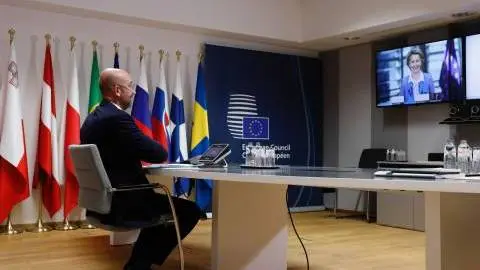Eurozone: Bottoming out
With the easing of the lockdown measures, growth is picking up in the eurozone albeit very gradually. Additional fiscal stimulus is being put in place but inflation is still going nowhere. The ECB has increased the size of its bond-buying programme, but we think it'll still be insufficient and a further increase in the second half of this year looks likely
Subdued recovery
The good news is that most recent data now indicates that the eurozone recession probably troughed in April.
The gradual opening of shops and factories pushed sentiment indicators slightly higher in May. That said, the upturn remains very cautious, which is not really a mystery in an economy where social distancing remains the norm. The latter also explains why services, where human interaction is key, has hardly seen any improvement; they'd already taken a big hit in the first quarter, falling 6.8%, while GDP shrank 3.6%.
Our GDP growth forecast remains at -8.0% for this year and +4.5% for next year
These are labour-intensive sectors of the economy, with often low paid workers with a high propensity to consume. On top of that, the Covid-19 crisis has accelerated some structural trends, necessitating some painful short-term adjustments. As an example, the boost e-commerce received from the lockdown is likely to accelerate the loss of employment in high street shops. Such trends could weigh on the strength of the recovery. We have slightly downgraded our second-quarter GDP, now expecting a contraction of close to 13%.
Our GDP growth forecast remains at -8.0% for this year and +4.5% for next year. As a reference, in its base case, the ECB is looking at an 8.7% GDP contraction this year, followed by a 5.2% expansion in 2021.
Improvement in manufacturing economic sentiment; services lagging

Fiscal boost continues to increase
France recently announced a 'cash for clunkers' scheme and a lengthening of temporary unemployment measures. There was also an increased subsidy to buy electric cars in Germany, as part of a bigger stimulus plan worth almost 4% of GDP.
The flipside of the strong fiscal stimulus is that budget deficits in most eurozone countries are expected to hit close to 10% of GDP this year and are not going to decline very rapidly
According to the Bundesbank, this package should add one percentage point to German GDP this year and 0.5% in 2021. The flipside of the strong fiscal stimulus is that budget deficits in most eurozone countries are expected to hit close to 10% of GDP this year and are not going to decline very rapidly. That would again bring a very delicate exercise that turned awry after the financial crisis: how to get budget deficits down without killing the recovery?
The common bond dream
The proposal from the European Commission to put in place a €750 billion recovery fund to help the countries that are most negatively impacted by the Covid-19 crisis is an interesting development, should it be approved by the European Council although we think it will be watered down.
The fact that the EU will actually issue bonds to finance the programme comes pretty close to issuing a common bond
While it might not be a game-changer in terms of a short-term stimulus (the grants in the programme would be worth about 0.7% of GDP per year for the coming four years), it would clearly be an important symbolic step towards more integration.
The fact that the European Union will actually issue bonds to finance the programme and request additional sources of income to service the debt, comes pretty close to the issuance of common bond.
Inflation still going nowhere

More QE in second-half of 2020?
A temporary VAT cut in Germany will probably push eurozone inflation into negative territory in the second half of the year. The ECB itself has more or less given up hope that it will reach its objective in the medium-term because the staff forecast for 2022 is now only 1.3% for headline inflation. That explains why the ECB felt comfortable in further increasing its Pandemic Emergency Purchase Programme (PEPP) by €600 bn with an extension of purchases until at least June 2021.
We think that this will probably still be insufficient and a further increase in the second half of this year looks likely. The only potential party pooper is the German constitutional court. While its verdict didn’t concern the PEPP, the Bundesbank’s position in the other bond-buying programmes could be compromised.
Even though ECB President Christine Lagarde stated that the ECB is confident that a good solution will be found, the matter could create some uncertainty in the short run.
Download
Download article
22 June 2020
Eurozone Quarterly: The gradual, but not great, re-opening This bundle contains 15 articlesThis publication has been prepared by ING solely for information purposes irrespective of a particular user's means, financial situation or investment objectives. The information does not constitute investment recommendation, and nor is it investment, legal or tax advice or an offer or solicitation to purchase or sell any financial instrument. Read more

